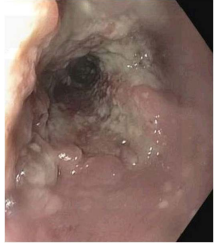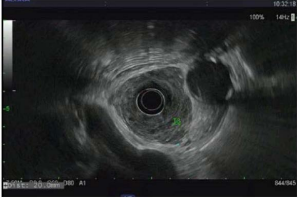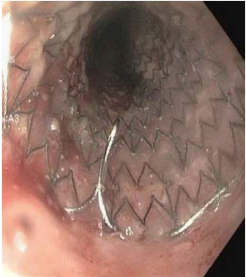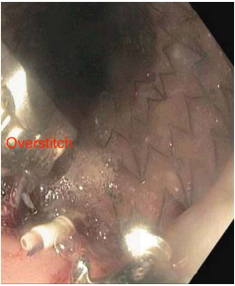1. Sharaiha RZ, Kumta NA, Doukides TP, et al. Esophageal stenting with sutures: It’s time to redefine our standards. J Clin Gastroenterol. 2015; 49(6): e57-e60. doi: 10.1097/MCG.0000000000000198
2. Schembre D. Advances in esophageal stenting: The evolution of fully covered stents for malignant and benign disease. Adv Ther. 2010; 27: 413-425. doi: 10.1007/s12325-010-0042-5
3. Langer FB, Schoppmann SF, Prager G, et al. Temporary placement of self-expanding oesophageal stents as bridging for neo-adjuvant therapy. Ann Surg Oncol. 2010; 17: 470-475. doi: 10.1245/s10434-009-0760-6
4. Eloubeidi MA, Lopes TL. Novel removable internally fully covered self-expanding metal esophageal stent: Feasibility, technique of removal, and tissue response in humans. Am J Gastroenterol. 2009; 104: 1374-1381. doi: 10.1038/ajg.2009.133
5. Holm AN, de la Mora Levy JG, Gostout CJ, Topazian MD, Baron TH. Selfexpanding plastic stents in treatment of benign esophageal conditions. Gastrointest Endosc. 2008; 67: 20-25. doi: 10.1016/j.gie.2007.04.031
6. Kim JH, Shin JH, Song HY. Benign strictures of the esophagus and gastric outlet: Interventional management. Korean J Radiol. 2010; 11: 497-506. doi: 10.3348/kjr.2010.11.5.497
7. Swinnen J, Eisendrath P, Rigaux J, et al. Self-expandable metal stents for the treatment of benign upper GI leaks and perforations. Gastrointest Endosc. 2011; 73: 890-899. doi: 10.1016/j.gie.2010.12.019
8. Baron TH. Minimizing endoscopic complications: Endoluminal stents. Gastrointest Endosc Clin N Am. 2007; 17: 83-104. doi: 10.1016/j.giec.2007.01.004
9. Saligram S. Lim D, Pena L, Friedman M, Harris C, Klapman J. Safety and feasibility of esophageal self- expandable metal stent placement without the aid of fluoroscopy. Dis Esophagus. 2017; 30(8): 1-6. doi: 10.1093/dote/dox030
10. Manes G, Corsi F, Pallotta S, Massari A, Foschi D, Trabucchi E. Fixation of a covered self expandable metal stent by means of a polypectomy snare: An easy method to prevent stent migration. Dig Liver Dis. 2008; 40: 791-793. doi: 10.1016/j.dld.2007.10.020
11. Silva RA, Dinis-Ribeiro M, Brandao C, et al. Should we consider endoscopic clipping for prevention of esophageal stent migration? Endoscopy. 2004; 36: 369-370. doi: 10.1055/s-0043-111793
12. Sriram PV, Das G, Rao GV, Reddy DN. Another novel use of endoscopic clipping: To anchor an esophageal endoprosthesis. Endoscopy. 2001; 33: 724-726. doi: 10.1055/s-2001-16207
13. Vanbiervliet G, Filippi J, Karimdjee BS, et al. The role of clips in preventing migration of fully covered metallic esophageal stents: A pilot comparative study. Surg Endosc. 2012; 26: 53-59. doi: 10.1007/s00464-011-1827-6
14. Rieder E, Dunst CM, Martinec DV, et al. Endoscopic suture fixation of gastrointestinal stents: Proof of biomechanical principles and early clinical experience. Endoscopy. 2012; 44: 1121-1126. doi: 10.1055/s-0032-1325730
15. Kantsevoy SV, Bitner M. Esophageal stent fixation with endoscopic suturing device (with video). Gastrointest Endosc. 2012; 76: 1251-1255. doi: 10.1016/j.gie.2012.08.003
16. Sharaiha RZ, Kumta NA, Doukides TP, et al. Esophageal stenting with sutures: Time to redefine our standards? J Clin Gastroenterol.2015; 49(6): e57-e60. doi: 10.1097/MCG.0000000000000198
17. Ngamruengphong S, Sharaiha RZ, Sethi A, et al. Endoscopic suturing for the prevention of stent migration in benign upper gastrointestinal conditions: A comparative multicenter study. Endoscopy. 2016; 48(9): 802-808. doi: 10.1055/s-0042-108567
18. Yang J, Siddiqui AA, Kowalski TE, et al. Esophageal stent fixation with endoscopic suturing device improves clinical outcomes and reduces complications in patients with locally advanced esophageal cancer prior to neoadjuvant therapy: A large multicenter experience. Surg Endosc. 2017; 31(3): 1414-1419. doi: 10.1007/s00464-016-5131-3









